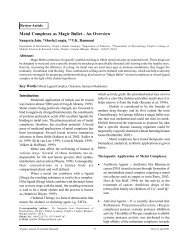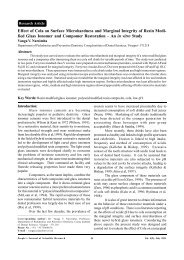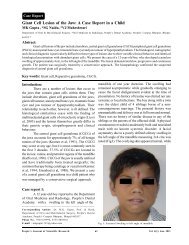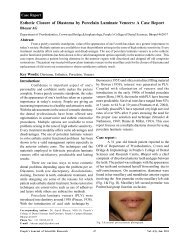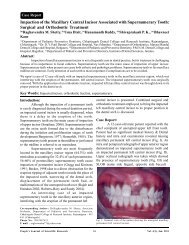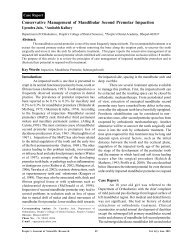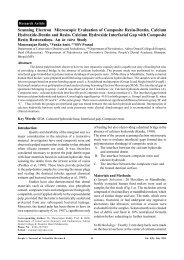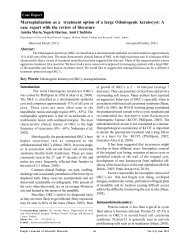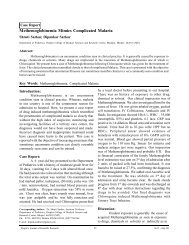Nutritional Status of Rural Pregnant Women - People's Journal Of ...
Nutritional Status of Rural Pregnant Women - People's Journal Of ...
Nutritional Status of Rural Pregnant Women - People's Journal Of ...
You also want an ePaper? Increase the reach of your titles
YUMPU automatically turns print PDFs into web optimized ePapers that Google loves.
Research Article<br />
<strong>Nutritional</strong> <strong>Status</strong> <strong>of</strong> <strong>Rural</strong> <strong>Pregnant</strong> <strong>Women</strong><br />
L.H. Madhavi, H.K.G. Singh<br />
Department <strong>of</strong> Community Medicine, *Department <strong>of</strong> Pediatrics, Khaja Banda Nawaz Institute <strong>of</strong> Medical Science,<br />
Gulbarga-585105 (Karnataka)<br />
Abstract:<br />
Pregnancy is a crucial period <strong>of</strong> woman’s life where socio-demographic factors affect her health as well as<br />
determine the health <strong>of</strong> future generation. A cross-sectional community based study was conducted in pregnant women in<br />
the field practice area <strong>of</strong> RCHTC, Hebbal. Variables considered for the study were: Age, religion, Socio-economics status,<br />
type <strong>of</strong> family & house, parity, spacing methods, utilization <strong>of</strong> health services, height, weight and Body Mass Index (BMI).<br />
Majority <strong>of</strong> pregnant woman had inadequate protien & calorie consumption during pregnancy; 23.93%, woman were<br />
having BMI
<strong>Nutritional</strong> <strong>Status</strong> <strong>of</strong> <strong>Rural</strong> <strong>Pregnant</strong> <strong>Women</strong> ----------------------------------------- L.H. Madhavi & H.K.G. Singh<br />
the study. A total <strong>of</strong> 117 pregnant women were included<br />
in the study. They were clinically examined and<br />
interviewed using pre-structured, pre-tested pr<strong>of</strong>orma.<br />
The B.G Prasad classification was used for socioeconomic<br />
status. Hemoglobin estimation was done by<br />
Salhi’s method. Anemia was classified as per WHO<br />
criteria (Park, 2005). The height was measured up to<br />
nearest <strong>of</strong> 1cm and weight up to nearest <strong>of</strong> 0.5kg. The<br />
chi-square & Z-test were used.<br />
Results:<br />
The present study showed that maximum<br />
number <strong>of</strong> pregnant women were Hindus (88.80%),<br />
moderate worker ( 87.15 % ) and were residing in<br />
kaccha house (92.30 %). Equal distribution <strong>of</strong> women<br />
was observed in nuclear type <strong>of</strong> family ( 48.70 %) and<br />
joint type <strong>of</strong> family (51.30%). Overall prevalence <strong>of</strong><br />
anemia was 66.67%. Similar prevalence was found in<br />
nuclear (48.72%) & joint (51.28%) type <strong>of</strong> families.<br />
High prevalence <strong>of</strong> anemia was noted in Hindus<br />
(92.31%), moderate worker (83.34%) and 96.16%<br />
pregnant anemic women were residing in kachha house<br />
(Table I).<br />
Table I: Distribution <strong>of</strong> women according to sociodemographic<br />
character & Anemia<br />
Characteristic<br />
Type <strong>of</strong><br />
family<br />
Nuclear<br />
Joint<br />
Type <strong>of</strong> house<br />
Kacha<br />
Pucca<br />
Type <strong>of</strong> work<br />
Heavy<br />
Moderate<br />
Religion<br />
Hindu<br />
Muslim<br />
Anemia<br />
n=78 (%)<br />
38(48.72)<br />
40(51.28)<br />
75(96.16)<br />
03(03.84)<br />
13(16.66)<br />
65(83.34)<br />
72(92.31)<br />
06(07.69)<br />
Normal<br />
n=39 (%)<br />
19(48.72)<br />
20(51.28)<br />
33(84.62)<br />
06(15.38)<br />
02(05.13)<br />
37(94.87)<br />
32(82.05)<br />
07(17.95)<br />
Total<br />
n=117 (%)<br />
² p-value<br />
value<br />
57(48.70) 0.000 p>0.05<br />
60(51.30)<br />
108(92.30)<br />
09(7.70)<br />
3.38 p>0.05<br />
15(12.85) 2.15 p>0.05<br />
102(87.15)<br />
104(88.80)<br />
13(11.20)<br />
2.77 p>0.05<br />
Maximum number <strong>of</strong> women (37.61 % ) were in the<br />
age group <strong>of</strong> 20-24 years followed by 35.90 % in the<br />
age group <strong>of</strong> 25-29 years, 15.38 % in the age group <strong>of</strong><br />
< 20 years and 11.11% in the age group <strong>of</strong> >30 years.<br />
Majority <strong>of</strong> women were married before 20 years <strong>of</strong><br />
age (88.03 %) followed by 10.26 % and 1.71 % in age<br />
group 20-24 year and > 25 years respectively. Age <strong>of</strong><br />
first pregnancy was < 20 years in 54.70% <strong>of</strong> women<br />
followed by 42. 74 % and 2.56 % in age groups <strong>of</strong><br />
20-24 years and > 25 years respectively at the time <strong>of</strong><br />
pregnancy. Gastational age <strong>of</strong> 62.39% women at the<br />
time <strong>of</strong> study was below 28 weeks. The prevalence <strong>of</strong><br />
anemia was maximum (39.74 % ) in the age group 20-<br />
24 years followed by 32.06%, 15.48 % and 12.82 %<br />
in the age group 25-29 years, < 20 years and > 30<br />
years respectively. High prevalence <strong>of</strong> anemia was<br />
observed in women who married ( 87.17%) and<br />
conceived (51.28% ) before 20 years <strong>of</strong> age. During<br />
pregnancy, anemia was more common (62.83%) below<br />
28 weeks <strong>of</strong> gestational age (Table II). 78.63%<br />
pregnant women were utilizing Govt. hospital health<br />
services. Choice for place <strong>of</strong> delivery was equal<br />
between hospital (49.57%) & home (50.43%). Overall,<br />
58.97 % <strong>of</strong> pregnant women were consuming Iron and<br />
folic acid tablets and 70.94% women received injection<br />
Tetanus Toxoid (TT). Most <strong>of</strong> the pregnant women<br />
(82.91%) were not using spacing method. Majority <strong>of</strong><br />
pregnant anemic women (76.92% ) were utilizing<br />
Govt. hospital health services, 64.11% consuming Iron<br />
and folic acid tablets and 73.07 % women were<br />
receiving injection TT. Maximum number (97.44%) <strong>of</strong><br />
pregnant anemic women were not using spacing<br />
methods. Choice for place <strong>of</strong> delivery among anemic<br />
pregnant women was hospital in 62.83% & home in<br />
37.17% (Table III).<br />
Table II: Distribution <strong>of</strong> women according to Age & Anemia<br />
Characteristics<br />
Age<br />
(in Years)<br />
30<br />
Age at<br />
marriage<br />
0.05<br />
50(42.74)<br />
03(02.56)<br />
73(62.39) 2.25 p>0.05<br />
44(37.61)<br />
Table IV shows that 76.92% were multigravida and<br />
66.67% multipara followed by primigravida (23.08%)<br />
and primipara (33.33%). Prevalence <strong>of</strong> anemia was<br />
high in multi para (77.63%) & multigravida (79.48%)<br />
People’s <strong>Journal</strong> <strong>of</strong> Scientific Research 21<br />
Vol. 4(2), July 2011
<strong>Nutritional</strong> <strong>Status</strong> <strong>of</strong> <strong>Rural</strong> <strong>Pregnant</strong> <strong>Women</strong> ----------------------------------------- L.H. Madhavi & H.K.G. Singh<br />
Table III: Distribution <strong>of</strong> women according to Utilization <strong>of</strong><br />
health services & Anemia.<br />
Health Services<br />
Service utiliza tion<br />
Govt. Hospital<br />
Private Hospital<br />
Spacing method<br />
Yes<br />
No<br />
Ta b Iron &<br />
Folic Acid<br />
Yes<br />
No<br />
Inj. TT<br />
Yes<br />
No<br />
Preference for<br />
Place <strong>of</strong> Delivery<br />
Hospital<br />
Home<br />
Table IV: Distribution <strong>of</strong> women according to Parity<br />
Gestational age and Anemia<br />
Parity (Gravida)<br />
Primi<br />
Multi<br />
All<br />
Gestationalage<br />
(>28 week <strong>of</strong> gestation)<br />
Primi<br />
Multi<br />
All<br />
Table V: Distribution <strong>of</strong> women according to BMI and<br />
Anemia.<br />
BMI<br />
25<br />
Anemia<br />
n=78<br />
(%)<br />
22(28.22)<br />
52(66.66)<br />
04(05.12)<br />
Normal<br />
n=39<br />
(%)<br />
6(15.38)<br />
32(82.06)<br />
01(2.56)<br />
Total<br />
n=117<br />
(%)<br />
28(23.94)<br />
84(71.79)<br />
5(04.27)<br />
²<br />
value<br />
p-value<br />
3.04 p>0.05<br />
Table VI: Distribution <strong>of</strong> women according to consumption<br />
<strong>of</strong> Calories & Protein.<br />
Nutrition<br />
K Cal/day<br />
0.05<br />
16.43 p0.05<br />
14.89 p0.05<br />
Age at marriage 18.4 + 2.09 18.3 +1.55 0.292 p>0.05<br />
Age <strong>of</strong> 1 st child 18+5.45 15.4 +7.85 1.86 p>0.05<br />
Gestational age 23.14 +7.16 22.62 +7.19 0.37 p>0.05<br />
Weight 45.9 +6.35 47+5.39 0.98 p>0.05<br />
Calorie/day 1707.47<br />
+292.89<br />
Protein/day 55.48<br />
+93.91<br />
1703.33<br />
+276.97<br />
99.87<br />
+152.36<br />
0.07 p>0.05<br />
1.67 p>0.05<br />
women having BMI <strong>of</strong> 25. Prevalence <strong>of</strong> anemia was high ( 78.57% ) among<br />
pregnant women having BMI
<strong>Nutritional</strong> <strong>Status</strong> <strong>of</strong> <strong>Rural</strong> <strong>Pregnant</strong> <strong>Women</strong> ----------------------------------------- L.H. Madhavi & H.K.G. Singh<br />
& 40 %) in the study by Chopra et al (1999).<br />
High prevalence <strong>of</strong> anemia was noted in less<br />
than 28 weeks <strong>of</strong> gestational age <strong>of</strong> pregnant women<br />
(62.83% ), the incidence is similar to that reported by<br />
Saxena et al (2000). The present study shows high<br />
prevalence <strong>of</strong> anemia in II nd trimester, illiterate pregnant<br />
women and who married (87.17%) and conceived<br />
(51.28% ) before 20 years <strong>of</strong> age indicating prepregnancy<br />
status <strong>of</strong> women. The present study shows<br />
that p-value is more than 0.05 for all variable<br />
parameters. Therefore, it shows that prevalence <strong>of</strong><br />
anemia was statistically not significant with relation to<br />
age <strong>of</strong> women, age at marriage, age at first child, weight,<br />
consumption <strong>of</strong> protein & calorie per day.<br />
The above parameters indicate that there is<br />
need for community based strategy to improve<br />
maternal nutritional status, literacy level, utilization <strong>of</strong><br />
Health Services and Health education with emphasis<br />
on delaying marriage and conception.<br />
8. World Health Organization: The prevalence <strong>of</strong> anemia in<br />
women: a tabulation <strong>of</strong> available information, 2 nd Edn.;<br />
WHO, Geneva, 1992.<br />
Acknowledgement<br />
I pr<strong>of</strong>usely thank Pr<strong>of</strong>.(Dr) S Tenglikar, Shri<br />
Srinivas Reddy statistician & All Medico Social Worker<br />
for their support & help for the completion <strong>of</strong> study.<br />
Author deeply acknowledges the support rendered<br />
by the pregnant women, Anganwadi workers , staff<br />
<strong>of</strong> Sub-center & RCHTC, for their whole hearted<br />
support during the study period.<br />
Bibliography:<br />
1. Chopra H, Jain S, Garg SK, Bhatnagar M, Singh JV: A<br />
<strong>Status</strong> <strong>of</strong> reproductives health among women in rural<br />
Meerut. Indian <strong>Journal</strong> <strong>of</strong> Preventive & Social Medicine,<br />
1999;30(3 & 4):116-119<br />
2. Gautam VP, Bansal Y, Taneja DK, Saha R: Prevalence <strong>of</strong><br />
anemia amongst pregnant women & its sociodemographic<br />
association in rural area <strong>of</strong> Delhi. Indian<br />
<strong>Journal</strong> <strong>of</strong> Community Medicine, 2002; 27(4):157-160.<br />
3. Govt. <strong>of</strong> India, Annual paper 2001-2002, Ministry <strong>of</strong><br />
Health and Family Planning. New Delhi, 2002.<br />
4. National nutrition policy, Ninth plan,(1997-2002) Vol. 11,<br />
Planning commission, Govt. <strong>of</strong> India, N Delhi. p:549.<br />
5. Park K: Park’s text book <strong>of</strong> preventive and social medicine.<br />
18 th Edn.; M/s Banarsi Bhanod, Jabalpur, 2005;pp450,465.<br />
6. Saxena V, Shrivastava VK, Idris MZ, Mohan U, Bhushan<br />
V: <strong>Nutritional</strong> status rural pregnant women. Indian<br />
<strong>Journal</strong> <strong>of</strong> Community Medicine, 2000; 25(3):104-107.<br />
7. Sachar RK, Kaur N, Soni RK, Dhat R, Singh H: Energy<br />
consumption during pregnancy & its relationship to birth<br />
weight: A population base study from rural Punjab. Indian<br />
<strong>Journal</strong> <strong>of</strong> Community Medicine, 2000;25(4):166-169.<br />
People’s <strong>Journal</strong> <strong>of</strong> Scientific Research 23<br />
Vol. 4(2), July 2011




